America: Taking History on Tour
Published on November 23rd, 2015
It began in 2015, the first-ever America’s Cup Tour with America, the 139-foot replica of the schooner that launched the America’s Cup tradition in 1851 by defeating the best the British could offer to win the Royal Yacht Squadron’s “100 Pound Cup.”
Troy Sears, owner of the America, initiated the program, beginning on the west coast of North America in 2015 before taking America through the Panama Canal to continue the tour in 2016 with stops along the Gulf of Mexico and Atlantic Ocean.
Scuttlebutt editor Craig Leweck checked in with Troy about 2015 and his plans for 2016 and beyond…
How much distance did you cover this year?
From July to September, we enjoyed 34 stops, beginning in San Diego and extending up north to Victoria, BC. Friday Harbor on San Juan Island, WA was our most northerly US stop. Also of note, we traveled up the Columbia River and through the Ballard Locks into Lake Washington which are Bucket List voyages for any sailor.
What was the vision for the tour?
After ORACLE TEAM USA won on Feb 14th, 2010, I was in Valencia with the team when the idea came to me to have the America tour the US to reconnect The America’s Cup with the US fan base. What we learned this year was how we all became very passionate about spending time with junior sailors and their instructors, sharing the history of the America and her role in US history.
The Millennials really don’t know about The America’s Cup and the America. I was constantly reminded of how I got involved in sailing at age 9 and the impact that sailing and The America’s Cup had on my life. I believe that sailing is the greatest activity to teach our children the value of self-reliance and the ability of converting fear into confidence through learning and experience. I hope we sparked the same passion with the juniors that came on board.
Describe the program that you presented.
It really changes at every venue depending on what is important to each club or organization. After all, we are there to serve. For example, at Port Townsend (WA) the locals are very knowledgeable about wooden boats, so the dockside tour of the America – with the ability to answer questions about 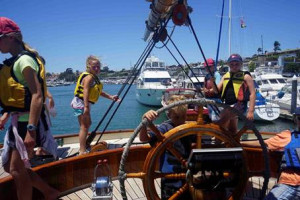 her build and rig – was really important. At Sail Sand Point (WA), it was about the juniors where there are over 200 kids in their programs. They are doing an amazing job. In Rainier (OR), they did not have a yacht club or sailing program, but we had a great day with their Boy Scout Troop. In San Francisco, it was a spirited sail under the Golden Gate which was most important.
her build and rig – was really important. At Sail Sand Point (WA), it was about the juniors where there are over 200 kids in their programs. They are doing an amazing job. In Rainier (OR), they did not have a yacht club or sailing program, but we had a great day with their Boy Scout Troop. In San Francisco, it was a spirited sail under the Golden Gate which was most important.
Did you find people were generally aware of the plans for the 2017 America’s Cup?
We learned that there are two worlds. Baby Boomers, like me, are aware of the America’s Cup, but generally only those who are sailors are aware of the winged-powered foiling catamarans and that the next defense is in Bermuda. So presenting video highlights from the AC 72’s in SF, or the recent ACWS events, are met with really cool reactions when they see the speed and technology of a modern AC yacht. And then, like mentioned above, Millennials are typically learning about The America’s Cup for the first time unless they are active in sailing.
Did you find the mood to be generally skeptical about the direction of the Cup, or enthusiastic?
This is an important question and we had robust conversations at every stop discussing the direction of the America’s Cup. Sailors very much want to be heard about how they feel about the direction of the Cup. They really care, and we listened. Once again, generally there is a split opinion depending which generation you come from.
For Baby Boomers, I have reached the following conclusion after hearing hundreds of fans. Most older fans like the America’s Cup the way it was since they were first introduced to America’s Cup in the 70’s or 80’s. I take a historical perspective about this. Imagine that your first time watching the America’s Cup was in 1903 and you saw the very high tech and nearly 200-foot long Reliance sailing. And then you grew older and the Depression came and it was announced that the AC would be sailed to a J-class rule in 130 footers. I am sure many older fans at the time may have been disappointed. But imagine again that in the 1930’s that was your first time watching the America’s Cup and you were in amazed by the J-boats and then you grew older and when the America’s Cup returned after WW II you watched the AC being sailed in 12-meter yachts that were slower and one half the size. Likewise, I am sure many older fans wished for the return to the J-class.
So I can understand why some fans prefer a return to their roots. Millennials are mostly enthusiastic that the AC is being held in the foiling cats with a great TV production. As for me, in 1851 America was sent to England to showcase American superiority in naval architecture at the first world’s fair. I think if they had a vessel that could do 50 knots in 1851, they would have surely brought it to England and then race her against the Royal Yacht Squadron. We talk about all the other issues too – nationality, commercialism, venue location, etc. It’s a healthy thing to put it all out on the table and that is what happens at each stop. The America’s Cup is now 164 years old and I look forward to what the future brings.
Any interesting discoveries along the tour?
I think by far the most important discovery is that clubs that are making significant investments into junior sailing are being rewarded in big ways. Tacoma Yacht Club (WA) is a good example. They made the commitment and their junior program has grown over 200% in just a few years. Most clubs do not have full membership, and they have an aging membership, and I think there is now a very clear path for success for the future. There are major changes happening in youth sports right now. Parents are re-thinking the best choices for their children as it relates to sports, and sailing offers a great alternative to some traditional sports.
What were the primary achievements of the 2015 tour?
Supporting junior sailing. Learning and sharing the important roles yacht club’s provide to their greater community. Introducing the America’s Cup to a new generation. And listening to America’s Cup fans with engaged and informed conversation. And of course, fantastic sailing with the members in great locations.
What is your 2016 plan?
Once we depart our home at the San Diego Maritime Museum, we want to visit every yacht club or organization of every size that can host the America from Mexico, Panama, every state from Texas to Maine and then the Caribbean before arriving in Bermuda. I am expecting over 120 port calls in 2016. I also want to bring more components from the new America’s Cup Class for guests to see for themselves.
When will America be in Bermuda?
Right now we expect to arrive in Bermuda by May of 2017 and hope to continue in our role of supporting ORACLE TEAM USA and will stay until the final race. And then I want get right back to the conversation.
Those interested in scheduling the America are encouraged to contact official.tour@americascup.com.
Additionally, Tucker Thompson, Host of the America’s Cup, is offering AC Presentations to Clubs across the country. The multi-media program includes an overview of the America’s Cup’s storied history including ORACLE TEAM USA’s dramatic comeback in San Francisco 2013, an update from the ongoing Louis Vuitton America’s Cup World Series, and an inside look at what to expect for the 35th America’s Cup in Bermuda. If interested, contact ACYCTour@americascup.com


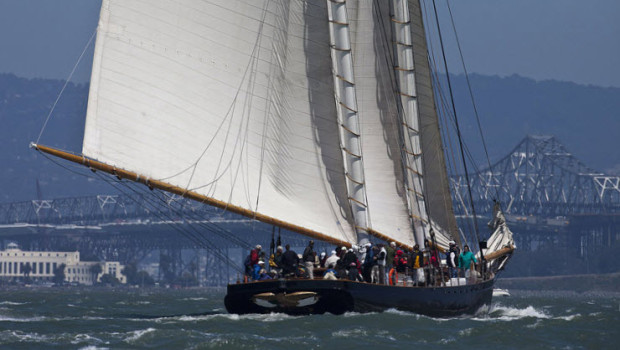

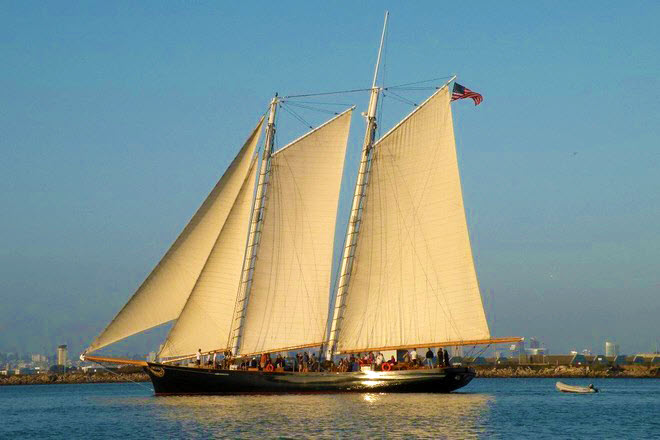

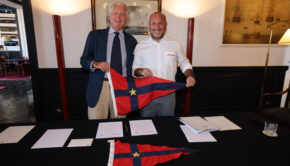
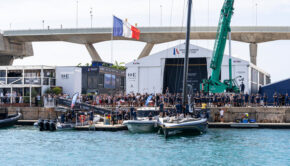


 We’ll keep your information safe.
We’ll keep your information safe.